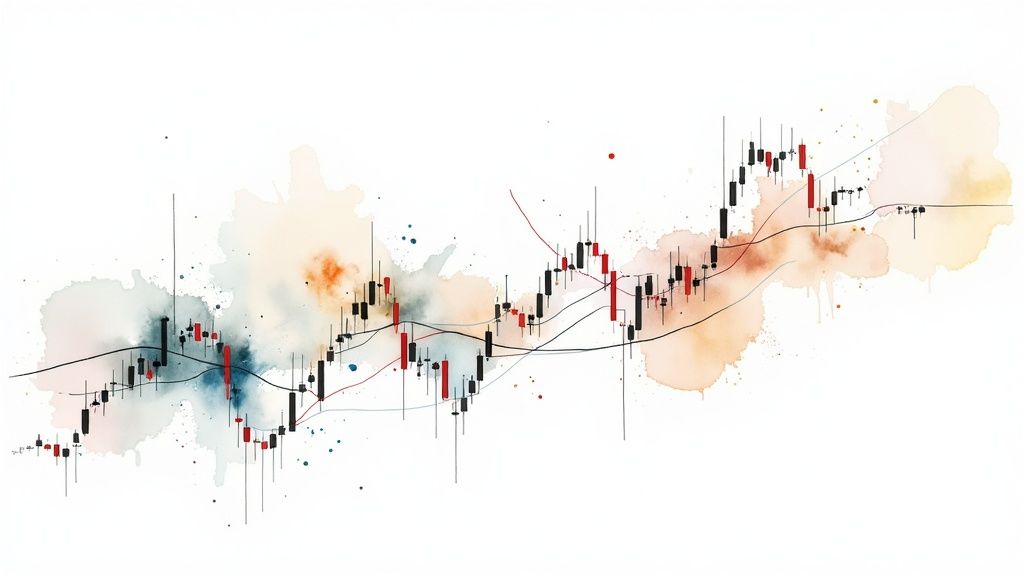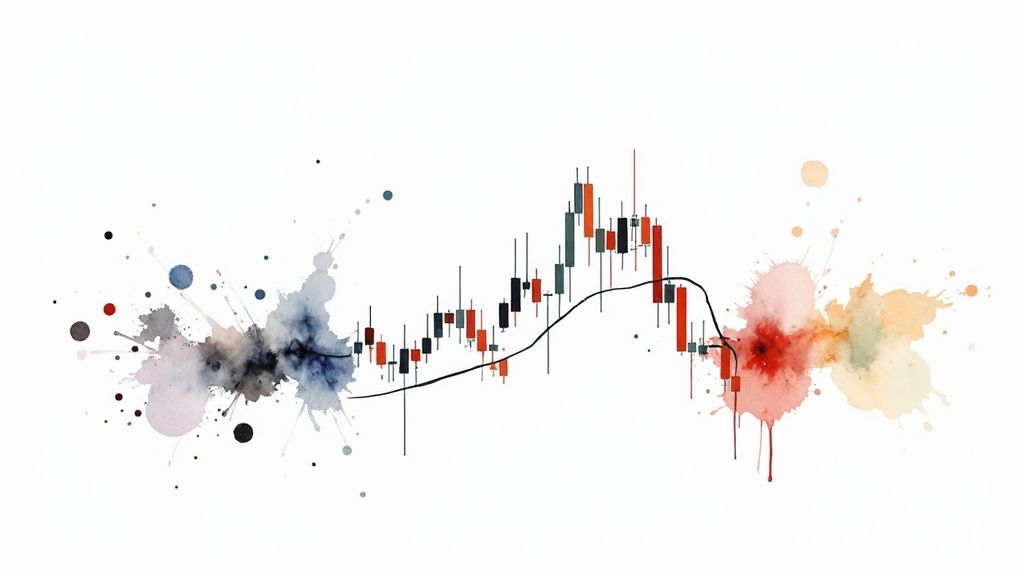




Successfully navigating the volatile cryptocurrency market demands a solid understanding of crypto signals. These signals function as informed suggestions, pointing towards potential trading opportunities unearthed through careful market analysis. But how can we break down the composition of a crypto signal and effectively interpret its message? The answer lies in understanding a few key components.
A well-constructed crypto signal typically presents the following crucial information:
Entry Point: This indicates the precise price at which a trader should consider entering a trade, whether buying or selling a specific cryptocurrency. A clearly defined entry point is paramount for maximizing potential returns.
Take-Profit Level: This specifies the target price at which an asset should be sold to secure profits. Setting realistic and achievable take-profit levels is a cornerstone of effective trading strategies.
Stop-Loss Level: This acts as a critical safety measure, defining the price at which a trader should sell to minimize potential losses if the market moves unfavorably. This element is essential for managing risk and protecting capital.
These three core components work in concert to form the foundation of a crypto signal, providing a structured roadmap for potential trades. However, the source and delivery method of these signals can greatly impact their overall effectiveness.
Crypto signals can originate from two primary sources: manual analysis by experienced traders and automated generation by algorithms. Manual signals often incorporate human insights and market intuition, leveraging years of accumulated trading knowledge. Automated signals, conversely, depend on pre-defined logic and technical indicators programmed to identify potential trading opportunities. The choice between these approaches depends on individual trading styles, risk tolerance, and personal preferences.
Furthermore, the cost and accessibility of signals vary widely. Free signals are widely available but may lack the depth and precision of premium services. Investing in a reputable premium signal provider can offer more nuanced analysis and potentially greater accuracy. However, conducting thorough due diligence and research is imperative before subscribing to any paid service.
Understanding the technical analysis (TA) underpinning signal generation is crucial for transitioning from passively following recommendations to actively interpreting market conditions. Crypto signals frequently rely on TA indicators to generate trading suggestions. Platforms like Good Crypto use TA summaries across different timeframes, such as 5-minute intervals for daily perspectives and 1-day intervals for yearly overviews. For example, if a signal suggests buying based on a bullish trend identified by moving averages, confirming this signal with other indicators like the Relative Strength Index (RSI) strengthens the analysis. This multifaceted approach ensures trading decisions are well-informed and based on comprehensive market assessment.
Finally, emotional management is paramount when using crypto signals. The cryptocurrency market is notoriously volatile, and experiencing losses can trigger impulsive decisions. Maintaining discipline and adhering to a predetermined strategy, even during periods of significant price fluctuations, is crucial for achieving long-term success. Therefore, understanding how to read crypto signals effectively encompasses not just deciphering the technical details but also managing emotional responses to market volatility.

The crypto signal landscape presents a complex mix of potential gains and significant risks. The sheer volume of providers makes it challenging to identify reliable services. Selecting the right provider can significantly improve trading outcomes, while a poor choice can lead to substantial losses. This section provides a framework for discerning credible signal providers from those offering unsubstantiated claims. We'll analyze key metrics, discuss warning signs, and outline essential due diligence practices.
Effective crypto signal interpretation requires a focus on verifiable performance metrics, moving beyond marketing hype and examining actual data. Key metrics to consider include:
Win Rate: While an attractive metric, win rate in isolation can be deceptive. It's essential to analyze the context of wins, considering factors like the timeframe and the risk-reward ratio. A high win rate with small gains might be less profitable than a lower win rate with larger gains.
Risk-Reward Ratio: This metric represents the potential profit relative to the potential loss for each trade. For example, a 2:1 ratio suggests a potential $2 profit for every $1 risked. A favorable risk-reward ratio is fundamental to sustainable trading.
Consistency: Prioritize providers demonstrating consistent performance across diverse market conditions. Consistent profitability, even if moderate, is a stronger indicator of reliability than sporadic success followed by large drawdowns. Evaluating historical performance provides valuable insights. For example, 4C-Trading reported a 65.33% win rate in January 2021, with 49 profitable signals out of 75 total. This verifiable data allows traders to assess a provider’s reliability. Learn more about historical performance here. However, remember past performance does not guarantee future results.
Transparency: Assess the provider's openness regarding their methodology and results. Are they transparent about their trading strategies, or do they operate in secrecy? Do they provide verifiable trade history, or are their claims unsubstantiated? Transparency is critical for establishing trust.
To help illustrate these key metrics, let's consider the following comparison:
Comparing Top Crypto Signal Providers
This table compares key metrics from leading crypto signal providers to help traders make informed decisions when choosing a service.
| Provider | Win Rate | Avg. Risk-Reward | Transparency Score | Cost | Special Features |
|---|---|---|---|---|---|
| Provider A | 70% | 1.5:1 | High | $100/month | Algorithmic Trading |
| Provider B | 60% | 2:1 | Medium | $50/month | Community Forum |
| Provider C | 80% | 1:1 | Low | $200/month | Copy Trading |
This comparison highlights the importance of considering all metrics. Provider C boasts a high win rate, but the low risk-reward ratio and transparency score raise concerns. Provider B offers a balance of win rate and risk-reward at a lower cost, while Provider A offers a good balance of win rate, risk reward and transparency but comes with a higher cost.
Just as certain characteristics indicate reputable signal providers, specific red flags should trigger caution:
Unrealistic Promises: Beware of providers guaranteeing profits or claiming implausibly high win rates. Consistent success in the volatile crypto market cannot be guaranteed.
Selective Reporting: If a provider only showcases winning trades while concealing losses, this is a serious warning sign. Transparent providers openly share both successes and failures.
Lack of Verifiable Data: Insist on verifiable performance proof. This could include independently audited track records or access to trading history on third-party platforms. Claims without verifiable data lack credibility.
High-Pressure Sales Tactics: Aggressive sales techniques, particularly those involving large upfront payments or limited-time offers, warrant skepticism.
Thorough due diligence is crucial before investing. This includes:
Researching the Provider: Investigate the provider’s background, experience, and reputation. Look for reviews and testimonials from other traders and seek independent verification of their claims.
Analyzing Their Methodology: Understand the rationale behind their signals. Do they employ sound technical analysis, or are their strategies based on speculation?
Testing With Small Amounts: Start with a small investment to evaluate the provider’s performance firsthand. This enables assessment of signal quality and risk management before risking significant capital.
By effectively interpreting crypto signals, focusing on key metrics, recognizing warning signs, and conducting thorough due diligence, you can navigate the complex crypto signal landscape and make informed decisions that protect and grow your portfolio.

Understanding the technical analysis underpinning crypto signals is paramount for evolving from a passive signal follower to an informed, active trader. This involves a deep dive into the core indicators that generate these signals. This section decodes some of the most impactful indicators and how they shape actionable insights.
Several technical indicators are instrumental in the formation of crypto signals. Developing the ability to interpret these indicators is akin to learning the language of the market.
Moving Averages: Moving averages smooth out price fluctuations over a defined period, revealing underlying trends and potential support or resistance levels. A classic example is the crossover of the 50-day moving average above the 200-day moving average, a common indication of a bullish trend and a key component of many buy signals.
Relative Strength Index (RSI): The Relative Strength Index (RSI), a momentum oscillator, gauges the velocity and magnitude of price movements. An RSI exceeding 70 often signals an overbought condition, suggesting a possible price correction. Conversely, an RSI below 30 can indicate an oversold condition, hinting at a potential buying opportunity.
Moving Average Convergence Divergence (MACD): The Moving Average Convergence Divergence (MACD) analyzes the relationship between two moving averages. A bullish crossover, where the MACD line rises above the signal line, can act as a buy signal trigger. A bearish crossover, where the MACD line falls below the signal line, may suggest a potential sell.
Bollinger Bands: Bollinger Bands chart standard deviations around a moving average, providing a visual representation of price volatility and potential breakouts. Narrowing Bollinger Bands can indicate declining volatility and the potential for a sudden price surge, directly influencing signal recommendations.
These indicators, in conjunction with other factors, form the bedrock of many crypto signals. A typical buy signal might be generated when the price surpasses a resistance level identified by Bollinger Bands, concurrent with a bullish MACD crossover and a rising RSI. This convergence of indicators strengthens the signal's validity and increases the likelihood of a profitable trade.
Seasoned traders understand the importance of independent validation. They don't blindly follow signals but instead cross-reference them with their own market analysis, employing confirmation techniques. For example, a trader might receive a buy signal based on a moving average crossover. However, they would likely seek confirmation from other indicators, such as increasing trading volume or a positive news event related to the specific cryptocurrency, before executing the trade. This multifaceted approach distinguishes successful traders.
Proficiency in interpreting these technical indicators is crucial for independent assessment of crypto signals. This empowers traders to confidently align signals with their personal risk tolerance and market outlook. Understanding the underlying technical foundations leads to more informed decisions, ultimately optimizing trading strategies and potentially maximizing returns. This knowledge enables traders to further refine their approach by filtering out signals that don't meet their specific criteria and concentrating on those with the highest probability of success. By mastering this technical language of the market, traders gain greater control over their trading outcomes.

The cryptocurrency market's 24/7 operation presents a significant monitoring challenge for human traders. This is where Artificial Intelligence (AI) and automation become invaluable. These technologies offer a distinct advantage, tirelessly analyzing market data and identifying potential trading opportunities around the clock. This continuous monitoring is crucial in the fast-paced crypto world, where even brief inactivity can result in missed opportunities or heightened risk.
AI-driven systems excel at processing massive datasets, far exceeding human capability. This allows them to detect subtle patterns and correlations often overlooked by human analysts. Moreover, AI algorithms operate without emotional bias, basing trading decisions solely on data and predefined parameters. This removes the risk of impulsive trades driven by fear or greed, common pitfalls for human traders. This results in a significant advantage in effectively interpreting crypto signals.
Furthermore, AI's ability to identify complex patterns allows for quicker adaptation to changing market conditions than human traders. This adaptability is critical in the volatile crypto market, which can shift dramatically based on various factors. For more insight into this, consider reading: Exploring the Role of Artificial Intelligence in Cryptocurrency Price Prediction.
Automated tools have become increasingly popular for generating crypto signals. These tools leverage algorithms and historical data to predict market movements. For example, Token Metrics utilizes AI technology to generate price predictions and trend signals, constantly refining them based on evolving market dynamics. This enables real-time analysis and rapid responses to market fluctuations, essential in the volatile crypto environment. However, validating the reliability of such tools by examining their past performance and user reviews is always crucial. You can learn more here.
Modern signal platforms are built upon advanced data science and machine learning principles. These models are trained on historical market data to identify patterns and trends with predictive power. However, human judgment remains vital. While AI excels at pattern recognition, humans provide critical thinking, risk assessment, and strategic decision-making.
Successfully integrating AI tools into a trading strategy requires balancing automation with human oversight. Traders should view AI-powered signals as valuable inputs, not absolute directives. Maintaining a critical perspective and validating signals against personal analysis and market understanding are essential. This oversight ensures that the AI tools align with individual trading goals and risk tolerance, maximizing automation benefits while mitigating potential downsides. This balanced approach strengthens the overall understanding of how to interpret crypto signals, giving traders a powerful combination of data-driven insights and human intelligence.
Even with highly reliable crypto signals, neglecting risk management can decimate trading accounts. This section focuses on building a robust risk management system to safeguard your capital. We'll explore position sizing, stop-loss strategies, take-profit approaches, diversification, and the pitfalls of overtrading. Practical examples will demonstrate how these parameters can preserve capital during market downturns and maximize returns during favorable market conditions.
Position sizing is the bedrock of risk management. It dictates the amount of capital allocated to each trade, preventing excessive exposure to any single asset. A common guideline is the 2% rule, which restricts the risk on any individual trade to 2% of your total portfolio value. For instance, with a $10,000 portfolio, the maximum acceptable risk per trade is $200. This means if a stop-loss order is triggered, the maximum loss incurred is $200.
Stop-loss orders automatically sell an asset when its price drops to a predetermined level, acting as a safety net against significant losses. Setting stop-loss levels requires a delicate balance, considering market volatility. Stop-losses set too tight can lead to premature exits during normal price fluctuations, while those set too wide can expose traders to substantial losses.
Percentage-Based Stop-Losses: These are calculated as a percentage below the entry price. For volatile assets, a wider stop-loss, perhaps 5-10%, might be appropriate. For less volatile assets, a tighter stop-loss of 2-3% could be used.
Support/Resistance-Based Stop-Losses: These leverage key support levels identified through technical analysis. A stop-loss positioned just below a support level aims to exit the trade before a significant price breakdown occurs.
Take-profit orders, mirroring stop-losses, automatically sell an asset when it reaches a predetermined profit target. Setting these levels involves balancing potential profit maximization against the probability of the target being reached. Realistic profit targets significantly increase the likelihood of securing gains.
Fixed Percentage Targets: Similar to percentage-based stop-losses, these are established a fixed percentage above the entry price. This locks in a pre-determined profit if the price reaches the target level.
Resistance-Based Targets: These orders utilize key resistance levels identified through technical analysis. The goal is to secure profits before a potential price reversal at the resistance level.
Diversification across various cryptocurrencies and signal types is crucial for mitigating risk. Concentrating solely on one asset or signal type creates vulnerability to market fluctuations specific to that area. However, overtrading, especially with multiple signals, can quickly erode profits due to increased transaction fees and the potential for emotional decision-making.
To illustrate effective risk management strategies across different trading styles, let's examine the following table:
Risk Management Strategies by Trading Style
This table outlines appropriate risk management parameters for different types of trading based on signal timeframes
| Trading Style | Position Size (%) | Stop Loss Range | Take Profit Targets | Max Open Positions | Risk-Reward Minimum |
|---|---|---|---|---|---|
| Scalping (Short-Term) | 1-2% | 0.5-1% | 1-2% | 5-10 | 1:1 |
| Day Trading (Medium-Term) | 2-3% | 1-2% | 2-5% | 3-5 | 1.5:1 |
| Swing Trading (Long-Term) | 3-5% | 2-3% | 5-10% | 1-3 | 2:1 |
As the table reveals, shorter-term trading styles like scalping necessitate tighter stop-losses and smaller position sizes to manage increased volatility, while longer-term swing trading allows for wider stops and larger positions. The risk-reward minimum also increases with the timeframe, reflecting the higher potential returns expected from longer-term trades.
Adhering to a well-defined risk management plan demands discipline, especially when signals underperform. Deviating from the plan due to emotional impulses can result in significant losses. A trading journal is a valuable tool for tracking performance, analyzing mistakes, and reinforcing discipline. By integrating crypto signals within a robust risk management framework, traders significantly improve their odds of success in the cryptocurrency market. Consistent application of position sizing, setting appropriate stop-losses and take-profit targets, and maintaining emotional control are vital. These practices are essential for navigating the volatility of cryptocurrency markets and preserving capital while seeking long-term profitability.
Cryptocurrency markets are inherently volatile, constantly fluctuating between trending, ranging, and volatile states. This dynamic nature necessitates an adaptive approach to interpreting crypto signals. Blindly applying the same strategy across all market conditions can lead to substantial losses. This analysis focuses on recognizing distinct market cycles and tailoring your signal implementation accordingly.
Effective interpretation of crypto signals requires differentiating between bull and bear market recommendations. A bull market, characterized by rising prices and positive sentiment, often sees signals focused on identifying optimal entry points for long positions to capitalize on upward momentum. These signals may emphasize momentum indicators and breakout patterns. Momentum Indicators are crucial during bull markets.
Conversely, in a bear market, characterized by declining prices and pervasive pessimism, signal strategies shift towards capital preservation. Short-selling signals become more prevalent, aiming to identify downward trends and entry points for short positions. Signals may also highlight safe haven assets or suggest reducing overall market exposure.
Identifying current market conditions is paramount. This involves analyzing price charts, observing trading volume, and monitoring market sentiment. A prolonged period of sideways price movement with low trading volume may indicate a ranging market. In such scenarios, signals promoting short-term trades within the established range could prove more effective than those advocating long-term positions.
Developing frameworks to determine when to increase aggression versus prioritize capital preservation is also essential. During bull markets, traders might increase position sizes or leverage based on signal confidence. However, in bear or volatile markets, reducing position sizes and emphasizing risk management becomes crucial.
High-volatility periods demand specific filtering techniques. Rapid price swings often generate false signals. Traders can employ stricter confirmation criteria, requiring multiple indicators to align before acting. Increasing stop-loss distances can also prevent premature exits triggered by volatility.
For example, if a buy signal occurs during high volatility, a trader might seek confirmation from a longer-term moving average or a surge in trading volume before entering the trade. This filters out potential false signals caused by volatile price action.
Validating signals against broader market trends is critical. Even if a signal suggests a buying opportunity for a specific asset, a significant market downturn could still lead to losses. Utilizing tools like Coindive's sector analysis and market sentiment tracking provides valuable context.
Consider receiving a buy signal for an altcoin while Coindive's analysis indicates widespread fear and uncertainty. This divergence might warrant caution, prioritizing capital preservation over a potentially risky trade.
Understanding market cycles and employing appropriate filtering techniques helps traders avoid misinterpreting signals during crucial market transitions. Adapting strategies to prevailing conditions ensures recommendations align with current market realities. This contextual understanding is fundamental for effective crypto signal utilization and maximizing trading outcomes.
The cryptocurrency market is constantly evolving; flexibility is key to long-term success. Mastering how to interpret crypto signals within varying market dynamics gives traders a distinct advantage, enabling them to navigate market turbulence with informed confidence.
Having explored the intricacies of reading and evaluating crypto signals, it's time to integrate these insights into a personalized system. This means developing a framework that aligns signal recommendations with your own analysis, risk tolerance, and investment goals. This section emphasizes the importance of building signal independence, using recommendations as valuable inputs rather than unquestionable commands.
A well-defined decision matrix empowers you to critically assess signals. This matrix acts as a personalized checklist, guiding your decision-making by considering multiple factors beyond the signal itself. This framework helps filter out less suitable signals and highlight those aligned with your specific trading strategy.
Signal Strength: Assess the signal's technical foundation. Does it rely on multiple confirming indicators? Does it align with broader market trends? A strong signal often exhibits convergence from several analytical perspectives.
Risk-Reward Profile: Evaluate the potential profit relative to the potential loss. Do the signal's suggested stop-loss and take-profit levels match your risk appetite? A high-risk signal might be suitable for a trader comfortable with volatility, but not for a more conservative investor.
Personal Analysis: Does the signal coincide with your independent market assessment? Your own research and understanding of market dynamics should complement the signal, leading to more informed decisions. Blindly following signals without independent validation can be detrimental to your portfolio.
Investment Objectives: Consider how the signal aligns with your overall investment goals. A short-term signal might suit a day trader, while a long-term signal might be more appropriate for a long-term investor. Aligning signals with your investment objectives ensures they contribute to your overall financial plan.
For example, consider a buy signal for Bitcoin generated by a provider. Your decision matrix would involve assessing the signal's strength based on converging technical indicators, evaluating the risk-reward profile by considering the suggested stop-loss and take-profit levels, comparing the signal with your own market analysis, and ensuring it aligns with your investment timeframe.
Maintaining a trading journal is crucial for tracking, analyzing, and refining your signal implementation. This journal becomes a valuable repository of insights, allowing you to learn from past trades and continually improve your decision-making process.
Record Each Signal: Document the source, rationale, entry and exit points, and risk parameters for every signal. This detailed record provides a structured foundation for later analysis.
Analyze Outcomes: Review both winning and losing trades to identify patterns and areas for improvement. What strategies proved effective? Where did the signals fall short? This retrospective analysis transforms each trade into a valuable learning opportunity.
Refine Your Approach: Use insights gleaned from your journal to adjust your decision matrix, risk management parameters, or signal filtering techniques. This continuous improvement cycle is essential for long-term success in the crypto markets.
While crypto signals offer valuable insights, they should not dictate your trading decisions. Signal independence means using signals as inputs rather than absolute directives. Think of signals as expert advisors, offering valuable perspectives that inform, but do not replace, your own judgment.
Maintain Strategic Autonomy: Your market analysis and risk assessment should always be paramount. Signals should complement, not override, your perspective. Maintaining strategic autonomy keeps you in control of your trading decisions.
Integrate Signals Strategically: Employ signals as one tool within your broader trading plan, not its sole foundation. Consider signals as one piece of the puzzle, not the entire picture. This approach allows you to integrate signals strategically, maximizing their benefits while mitigating potential downsides.
Successful traders consistently maintain strategic autonomy by critically evaluating signal recommendations against their own market understanding and risk tolerance. They view signals as valuable sources of information that enrich their analysis, not blind instructions to be followed without question. They understand that market conditions are dynamic and signals may not always be accurate, reinforcing the importance of independent analysis. For instance, a signal might suggest buying a particular cryptocurrency, but a trader might observe negative news or concerning price patterns, leading them to disregard the signal. This ability to critically evaluate signals based on independent analysis and market understanding is crucial for consistent profitability.
By integrating signals into a personalized system incorporating a decision matrix, diligent journaling, and an emphasis on independent analysis, you can make informed decisions that align with your individual trading style and investment goals. This methodical approach to using signals empowers you to navigate the crypto market more effectively, increasing your chances of long-term success. Ready for a deeper dive into crypto? Explore Coindive today for comprehensive market insights, community sentiment analysis, and personalized alerts.